Texas A&M University Galveston researchers join NOAA investigation of Monterrey Shipwrecks in the Gulf of Mexico
 For research scientists, archaeologists and students from Texas A&M University at Galveston, the deep-sea discovery of three 19th Century ships only 180 miles from their campus was like finding treasure in a new world. But they didn’t have to sail to the site, nor did they have to take the 4,300 foot plunge to the ocean’s depths. Instead, they explored the shipwrecks, while firmly anchored to Texas A&M’s Exploration Command Center in the heart of Galveston’s campus.
For research scientists, archaeologists and students from Texas A&M University at Galveston, the deep-sea discovery of three 19th Century ships only 180 miles from their campus was like finding treasure in a new world. But they didn’t have to sail to the site, nor did they have to take the 4,300 foot plunge to the ocean’s depths. Instead, they explored the shipwrecks, while firmly anchored to Texas A&M’s Exploration Command Center in the heart of Galveston’s campus.
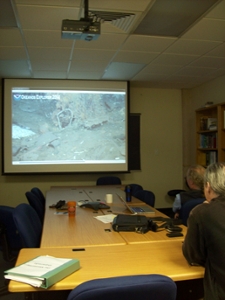 Thomas Heathman, a marine biology doctoral student and part of a new breed of virtual explorers, was present during discoveries of what are now known as the Monterrey Shipwrecks.
Thomas Heathman, a marine biology doctoral student and part of a new breed of virtual explorers, was present during discoveries of what are now known as the Monterrey Shipwrecks.
“I grew up hearing about pioneers discovering the new world and astronauts going into space,” Heathman said. “There’s that same excitement in surveying the sea, but in space there’s no gravity. In the ocean, there’s intense water pressure. Astronomers look at stars through a telescope. We look at the depths of the ocean with remotely-operated vehicles.”
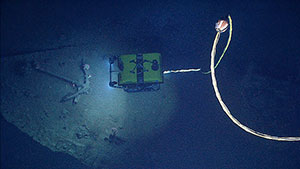 Using remotely operated vehicles tethered to research vessel, scientists and their affiliates, including Texas A&M Galveston, The Meadows Center for Water and the Environment at Texas State University, the Department of the Interior Bureau of Ocean Energy Management investigated the shipwrecks last year after the vessels were located during an oil company survey. The project was coordinated and funded by NOAA’s Office of Ocean Exploration and Research.
Using remotely operated vehicles tethered to research vessel, scientists and their affiliates, including Texas A&M Galveston, The Meadows Center for Water and the Environment at Texas State University, the Department of the Interior Bureau of Ocean Energy Management investigated the shipwrecks last year after the vessels were located during an oil company survey. The project was coordinated and funded by NOAA’s Office of Ocean Exploration and Research.
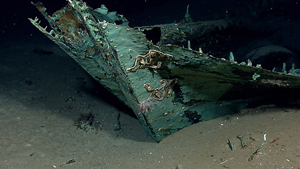 Linked by technology to the research vessel, command center participants like Heathman gathered around tables with laptops, peered at a wall-sized monitor and deliberated about what was being viewed on the floor of the Gulf during the actual exploration of the ships. What they saw were extraordinary creatures, exquisite seascapes and remnants of human history.
Linked by technology to the research vessel, command center participants like Heathman gathered around tables with laptops, peered at a wall-sized monitor and deliberated about what was being viewed on the floor of the Gulf during the actual exploration of the ships. What they saw were extraordinary creatures, exquisite seascapes and remnants of human history.
Last year, researchers found a tremendous variety of artifacts including navigational equipment, muskets, cannons, hides, tallow and even medicinal supplies like ginger used to treat sea sickness. This year’s expedition discovered an antique clock. Evidence suggests these are three early 19th Century ships that may have sunk in a storm.
 Dr. Frederic Pearl, director of the Maritime Studies Program at Galveston said that the wrecks are very well-preserved from an archaeologist’s viewpoint.
Dr. Frederic Pearl, director of the Maritime Studies Program at Galveston said that the wrecks are very well-preserved from an archaeologist’s viewpoint.
“It was like taking a field trip to the bottom of the Gulf,” he said. “Beyond their visual fascination, students listened in on the exploration team’s conversations, which demonstrated to them the kinds of things scientists find interesting about these wrecks. Students from different disciplines chatted together, one explained biology to the other who explained archaeology in return. It was an enhanced learning experience.”
Thomas Oertling, Texas A&M Galveston instructional assistant professor of Nautical Archaeology, said thousands of ships lie at the bottom of the Gulf.
“Many are found near reefs close to shore,” he said. “So the three vessels we examined were found far from land and so close to each other that they appear to have been traveling together and went to the seafloor at the same time.
One of the vessels was armed, and researchers theorize that was a pirate ship or a privateer authorized with a document known as a “Letter of Marque” to prey upon shipping of an enemy country. It’s speculated that the other two ships were captured vessels.
Seed ships
 Although the shipwrecks are a mystery, they are not the only mysteries to be solved.
Although the shipwrecks are a mystery, they are not the only mysteries to be solved.
Texas A&M Galveston marine biologist Dr. Gilbert Rowe says a variety of deep-sea habitats and features being explored have also revealed new and spectacular biological and geological discoveries.
“Working with NOAA to explore sea-floor features is an emerging opportunity for our students and faculty, Rowe said. “We anticipate much more of this collaboration in the future.”
Heathman said looking at the density of sea life surrounding the ships is like seeing an underwater city for marine life.
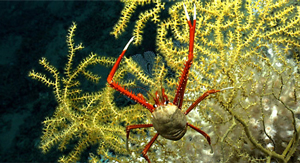 “We’re trying to see what life is there and how far this life extends from the ships,” he said. “We’re looking at how organisms arrived at the shipwreck and how they change overtime. We’re noting how the decaying ships are fueling this biology as the ships’ wood and contents become a source of food for marine life.”
“We’re trying to see what life is there and how far this life extends from the ships,” he said. “We’re looking at how organisms arrived at the shipwreck and how they change overtime. We’re noting how the decaying ships are fueling this biology as the ships’ wood and contents become a source of food for marine life.”
“Dr. Mary Wicksten, Texas A&M marine biologist, also participated and provided valuable guidance in species identifications as she followed the explorations live from her office in College Station.
“On shipwrecks, we saw evidence of deep-sea shipworms destroying the wood, but also peculiar tube worms that associate with bacteria among decomposing material at the sea floor,” Wicksten said. “We ran across a community of worms that expand and contract in a wave and seem to specialize in life on decomposing 150-year old cowhides. These worms and their community almost surely are new to science.”
Seafloor discovery
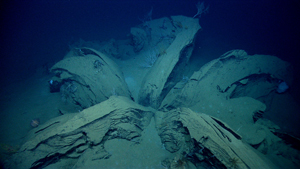 Beyond historical and biological breakthroughs, an amazing discovery was made, when NOAA investigated a sonar ping thought to be another shipwreck.
Beyond historical and biological breakthroughs, an amazing discovery was made, when NOAA investigated a sonar ping thought to be another shipwreck.
“On the monitor, it looked like it could have been a shipwreck,” Heathman said, “But, we saw something we’ve never seen before in the northern Gulf of Mexico.
Viewed from above, the feature looked like a dark flower swirling up from the floor of the Gulf. It was actually solidified asphalt that had emerged from deep within the seafloor.
Dr. William Kiene, a regional scientist with NOAA’s Office of National Marine Sanctuaries said that the feature was formed when oil deposits deep beneath the seafloor migrated upward and solidified when the oil came into contact with the cold seawater.
“As it got close to the surface, its consistency was like plastic, and it extruded into a flower-like shape,” Kiene said. “The mass of asphalt is now solid and suggests it “bloomed” long ago, but because it’s supporting organisms like tubeworms, we know that some volatile hydrocarbons are still being produced. It’s fascinating to discover how these geological processes bring life to an ecosystem.”
Dream-come-true
“I’ve always wanted to work with the ocean and do biology,” Heathman said. “Today, I’m part of something big — exploring the last frontier on the planet, and fulfilling my dream of becoming a marine biologist.
Opportunities continue for students and the public to join live explorations of the Gulf of Mexico and beyond. In June, Bob Ballard —known for his deep sea exploration such as the Titanic expedition—will begin a four-month mission to the Gulf of Mexico and Caribbean Sea with live broadcasts from the deep seafloor at http://nautiluslive.org. Highlights of the Okeanos Explorer mission to the Gulf and further missions can be followed at http://oceanexplorer.noaa.gov. Texas A&M’s Exploration and Command Center will be live and online for the next Gulf of Mexico exploration.
Photographs are courtesy of NOAA’s Okeanos Explorer Program 2014 Expedition.
Media Contact: Cathy Cashio Bertrand, Texas A&M Galveston Communications and Media Relations Director, 409-740-4830 or cashioc@tamug.edu